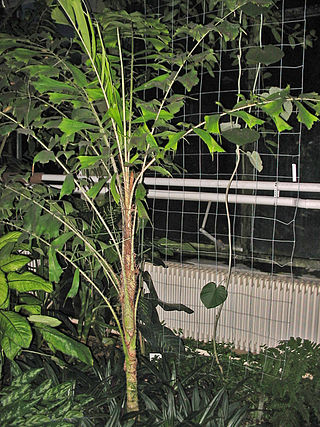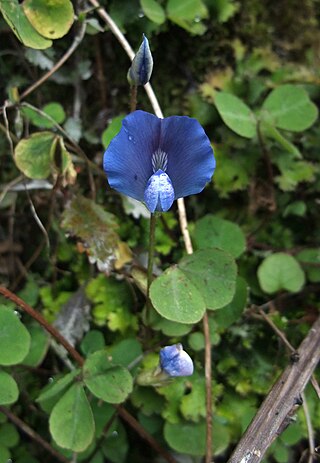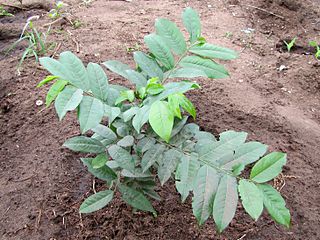
Aextoxicon is a genus of dioecious trees native to southern Chile and Argentina. It is the only genus in the monotypic family Aextoxicaceae, and is itself represented by the olivillo. It is a large evergreen tree native to the forests of the Valdivian temperate rain forests and Magellanic subpolar forests of the Pacific coast of southern Chile, where it forms is a canopy tree in the broadleaf forests. It can reach 15 m tall.

Menyanthes is a monotypic genus of flowering plants in the family Menyanthaceae containing the single species Menyanthes trifoliata. The North American form is often referred to as M. trifoliata var. minor Michx. It is known in English by the common names bogbean and buckbean.

Aiphanes is a genus of spiny palms which is native to tropical regions of South and Central America and the Caribbean. There are about 26 species in the genus, ranging in size from understorey shrubs with subterranean stems to subcanopy trees as tall as 20 metres (66 ft). Most have pinnately compound leaves ; one species has entire leaves. Stems, leaves and sometimes even the fruit are covered with spines. Plants flower repeatedly over the course of their lifespan and have separate male and female flowers, although these are borne together on the same inflorescence. Although records of pollinators are limited, most species appear to be pollinated by insects. The fruit are eaten by several birds and mammals, including at least two species of amazon parrots.

Schoepfia is a genus of small hemiparasitic trees, flowering plants belonging to the family Schoepfiaceae. The genus has long been placed in the Olacaceae family.

Parochetus communis, known in English as shamrock pea or blue oxalis, is a species of legume, and the only species in the genus Parochetus and in the subtribe Parochetinae. It is a low-growing plant with blue papilionaceous flowers and clover-like leaves. It is found in the mountains of Asia and tropical Africa, and has been introduced to New Zealand.
Englerodendron vignei is a species of tree in the family Fabaceae endemic to tropical West Africa. It is found in Ghana, Côte d'Ivoire, Liberia, and Sierra Leone. It is threatened by habitat loss.

Hypericum tortuosum is a species of flowering plant in the genus Hypericum. It is found only in Socotra, Yemen, where it is endemic. The species is an apomorphic relative of the other Socotran species in Hypericum sect. Triadenioides and is most closely related to Hypericum scopulorum. Its natural habitats are subtropical or tropical dry forests and subtropical or tropical dry shrubland.

Itaya amicorum is a medium-size fan palm that is native to Brazil, Colombia and Peru. It is the only species in the genus Itaya. It was unknown to science until 1972, when it was discovered on the bank of the Itaya River in the Peruvian Amazon.

Brunfelsia portoricensis, the Puerto Rico raintree, is a species of flowering plant in the family Solanaceae. It is endemic to Puerto Rico, where it occurs in El Yunque National Forest.

Helicia is a genus of 110 species of trees and shrubs, constituting part of the plant family Proteaceae. They grow naturally in rainforests throughout tropical South and Southeast Asia, including India, Sri Lanka, Indochina, Peninsular Malaysia to New Guinea and as far south as New South Wales.
Illicium tenuifolium is a species of flowering plant in the family Schisandraceae. It is a tree native to Indo-China and Peninsular Malaysia. It grows in tropical forests, including cloud forests.

Mkilua is a genus of plant in the family Annonaceae. It is native to Kenya and Tanzania. It contains a single species, Mkilua fragrans. Bernard Verdcourt, the British botanist who first formally described the species, named it after the fragrance of its flowers which smell like lemon. It is commonly called Mkilua Mwitu, Kilua and Kiluwa in Swahili, and Kingade in Digo. Volatile oils extracted from its leaves, flowers, and aerial parts have been reported to be repellent to Anopheles gambiae mosquitoes which are vectors for the malaria parasite Plasmodium falciparum. Bioactive molecules extracted from its roots have been reported to have antimicrobial activity in tests with Streptococcus agalactiae and Staphylococcus aureus.
The false oranges are a group of flowering plants in the Citrus genus, within the family, Rutaceae. They are endemic to New Caledonia.

Phyllanthus anamalayanus is a species of plant in the family Phyllanthaceae. It is endemic to the Anamalai Hills in Coimbatore district in the state of Tamil Nadu, India. The species is a shrub or small tree occurring in the understorey of mid-elevation tropical wet evergreen forests in the Anamalai Hills, and is endemic to the Western Ghats. It is threatened by habitat loss.
Pseudoxandra williamsii is a species of plant in the Annonaceae family. It is endemic to Peru. Robert Elias Fries, the Swedish botanist who first formally described the species using the basionym Cremastosperma williamsii, named it after Llewelyn W. Williams, the Welsh economic botanist, who collected the holotype specimen he examined.
Burnatia is a genus in the family Alismataceae. It includes only one currently recognized species, Burnatia enneandra. It is native to tropical and southern Africa from Senegal to Tanzania to South Africa. Among genera of the Alismataceae, it can be distinguished by not having a differentiated perianth, and being dioecious, with male and female flowers on separate individuals. Male flowers have 6 to 9 stamens and female flowers have many carpels and up to 2 staminodia.
Bulbophyllum nocturnum is a species of epiphytic orchid that grows in New Britain. It was described in 2011, and is the first species of orchid known to consistently flower during the night, and close its flowers during the day.

Hypericum aciferum is a species of flowering plant in the St John's wort family Hypericaceae. It is a small shrub endemic to the Greek island of Crete. H. aciferum grows in a mat on the ground and has twisting branches, needle-like leaves, and long golden petals. Its flowers are also heterostylous, which means that the species can exhibit one of two flower types on different plants. This trait is unique within the genus Hypericum to H. aciferum, H. russeggeri, and H. aegypticum, the three species in section Adenotrias.
Chunia bucklandioides is a species of flowering plant belonging to the family Hamamelidaceae. It is a tree native to Hainan and northern Vietnam. It is the sole species in genus Chunia.

Uvariopsis guineensis is a species of plant in the Annonaceae family. It is native to Guinea, Ivory Coast, Liberia, and Sierra Leone. Ronald William John Keay, the botanist who first formally described the species, named it after Guinea, then called French Guinea, where the specimens he examined were collected near a locality he identifies as Fassakoidou.













